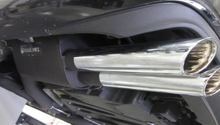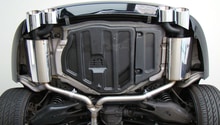Mercedes-Benz C-Class: Exhaust Modifications
Just because your C-Class isn't an AMG model from factory doesn't mean you can't make it sound or perform like one. Outlined below are multiple ways to upgrade the performance of your C-Class exhaust system.
This article applies to the Mercedes-Benz Non-AMG C-Class (2007-2014).
Internal combustion engines produce power in different ways, but without getting into details, the exhaust system plays one of the biggest roles in generating the needed force to complete the process. The exhaust system's job is to compress the gases that come from the engine, channel them through the exhaust piping, clean up the fumes (cat), and then push them out the muffler as hard and clean as possible. So, you can think of it as a big, powerful filter that makes your car sound good and generate horsepower via back-pressure. There are multiple parts to an exhaust system; below is a guide that explains how each component can positively affect the performance of your C-Class.
Exhaust Modifications
The are some common exhaust modifications that you can find plenty of information on based on the experiences of other C-Class owners.
The most common exhaust modifications are broken up into the following segments:
- Headers
- Turbo Downpipe
- Midpipe (a.k.a. center section, x-pipe)
- Axle-back
Headers

DIY Cost –$800 to $1,500 for parts
Professional Cost – $400 to $1,000 for labor
Skill Level – Difficult; Requires specialty tools and knowledge and may involve welding and the help of another person.
For the C300 and C350, headers are the first set of pipes which the exhaust gases coming off the engine block go through. So headers play a crucial role in managing those gases and sending them down the system in the most efficient and packaged way possible. Headers can range in price from a couple of hundred bucks to thousands of dollars depending on the complexity of the pipes, the material they are made out of, as well as the amount of dyno research done to develop the part. Headers will most likely deliver horsepower and torque gains.
Turbo Downpipe
DIY Cost – $800 to $1,100 for parts
Professional Cost – $1,000 to $2,000 for parts; $250 to $1,000 for labor
Skill Level – Difficult; Requires specialty tools, knowledge and may involve welding.
On a turbocharged engine such as the one in the C250, upgrading the turbo downpipe could tap into the power your engine is already generating, but yield even more than it currently is. The factory equipped downpipe has a large catalytic converter in it, which, although great for emissions controls, is less than stellar for those chasing power gains. Upgrading to a larger diameter, "cat-less" downpipe can enjoy gains in excess of 30HP/30TQ, as well as a quicker spooling turbo due to the lessened restrictions in the exhaust piping. For the C250, this part of the exhaust offers the largest gains.
Midpipe

DIY Cost – $250 to $600 for parts
Professional Cost – $400 to $800 for parts; $300 to $1,200 for labor
Skill Level – Moderate; Some center sections are plug and play, others require cutting and welding to fit.
For the C300/350, the center section is the immediate area after the exhaust manifolds (headers). For C250 models, this is the portion of the exhaust piping down stream of the down-pipe. The exhaust midpipe, center section, or the "x-pipe", normally complements the headers by allowing the exhaust gases to flow throughout the same material and diameter of exhaust as the headers. Therefore, a uniform flow from beginning to end is achieved. Modifying the midpipe is normally only done when upgrading the entire system, as replacing it by itself will normally not have any positive or negative impacts in performance. Think of it as a "compliment" to the exhaust system.
Axle-Back

DIY Cost – $1,800 to $3,000 for parts
Professional Cost – $2,500 to $4,000 for parts; $600 to $1,500 for labor
Skill Level – Easy; Most axle-back exhausts are plug and play, able to be installed with hand tools, and very few models require welding.
The axle-back exhaust is is a common exhaust installed in a Mercedes-Benz and any car in which the owner wants to upgrade the exhaust system. The reason why it is called an axle-back exhaust is because it only replaces or upgrades the parts from the rear axle to the exhaust tips. Axle-back exhausts can vary wildly in price depending on materials used to fabricate the system, research, and development performed, and could also involve high installation costs.
Related Discussions
- X-Pipe Installation W204 - MBworld.org
- Eisenmann Exhaust for W204 Mercedes- MBworld.org
- C300/350 Header Discussion - MBworld.org
- C250 Quad Exhaust and Downpipe - MBworld.org
- C250 Downpipe Pics - MBworld.org






